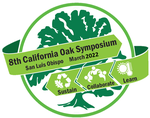#23

Thomas Scott, Department of Environmental Science Policy and Management Environmental Science, Policy and Management, University of California Berkeley and Department of Earth and Planetary Sciences, University of California, Riverside
Kim Camilli, Forest Pathology and Entomology Program, California Department of Forestry and Fire Protection.
Jan Gonzales, University of California Cooperative Extension, San Diego County
Beatriz Nobua-Behrmann, University of California Cooperative Extension, South Coast Research and Extension Center
Kevin Turner, California Department of Forestry and Fire Protection (retired).
The Goldspotted oak borer (Agrilus auroguttatus, hereafter GSOB) was linked to oak declines in 2008, over 12 years after it arrived in southern California. By that time, it had occupied over 7,500 acres of oak woodlands in San Diego County, infesting primarily California Black oak (Quercus kelloggii) and coast live oak (Quercus agrifolia). Now 25 years past its earliest time of detection, this invasive exotic beetle occupies over 150,000 acres of oak woodlands in California, having spread by diaspora to 4 other counties (Riverside, Orange, Los Angeles, San Bernardino). The primary means of dispersal is transport of larvae/pupae in the bark of infested-oak firewood. The longest known diaspora by firewood was 120 miles, which places over 100,000 acres of hardwood range in the Coast Ranges and southern Sierra within a radius of infestation risk by GSOB.
New outbreaks are typically discovered 3 to 5 years after infestation, suggesting that education outreach in at-risk communities is a stronger strategy than early detection. Because of this lag time in outbreak discovery, management has evolved to slow oak morbidity and mortality with little hope for eradication. Management options currently focus on prophylactic/remedial treatment of individual oaks, based on vulnerable points in the life history of GSOB and triage of oaks in infested woodlands. Pesticide bark-barrier sprays have been the most effective treatment, because they potentially to kill both emerging adults and larvae entering the surface of the bark. At a population level, management is focused on GSOB hot spots within outbreak areas, and the identification of the heavily infested oaks that amplify GSOB outbreaks. However, at the time of discovery, many managers opted to treat all large oaks within an infested woodland.
Initial years of the GSOB outbreak occurred during a period of record drought in San Diego County, with a devastating impact on mature oaks. Since that time the loss of oaks to GSOB has risen and fallen with annual precipitation. GSOB typically contributes to the mortality rate of all large red oaks (>20 inches), but with a small number of intriguing individuals (Quercus agrifolia) that appear to be resistant to GSOB infestation.
